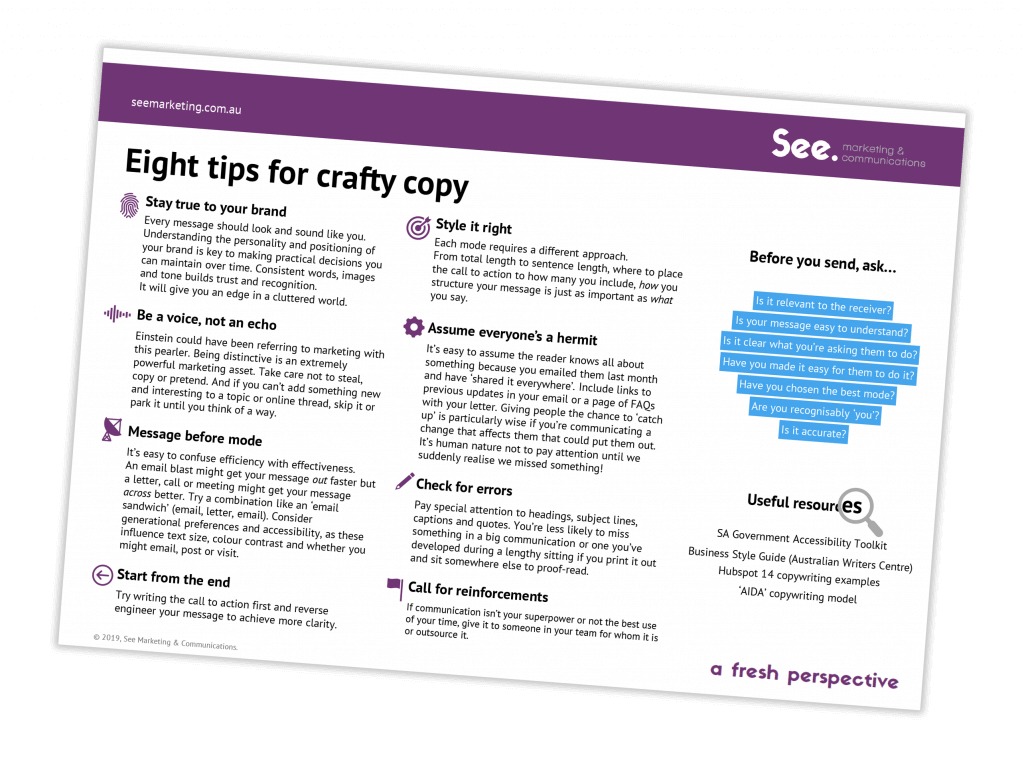If you are looking for tips on setting your prices, this article might help.
I was approached by Vision Beyond Business owner, Vanessa Bamford, to answer common questions businesses asked her about setting prices from a marketing perspective. This article has been adapted and expanded with additional tips to help you make the decision that’s right for you.
Q1. I’m struggling to know how to price my service. I know I need to be competitive, but I don’t want to short-change myself. Where do I start?
The first step to setting your prices is to be clear about whether you sell a service or goods.
Selling services
You sell a service if you charge people to access your expertise, experience, or sphere of influence. Examples of this are professional services such as bookkeeping and business advisory. Your value is held in how you use your skills, experience, and connections to meet the needs of your clients. Typically, you charge on an hourly rate or create a value-based package (time and level of expertise required to deliver the service and perceived value of the outcome from your client’s perspective). There is a high degree of tailoring because a service is by nature, about responding to the unique situation of each particular client.
Selling goods
Goods tend to be standardised off-the-shelf solutions to common needs among a group of consumers. They are usually manufactured, regardless of whether they are produced in advance at scale or made to order. Examples of this include cosmetics, clothing, and wine.
Selling products
A product is a term that can apply to both services and goods. In the case of a service, a product usually refers to a fixed-cost service, often with a structured generic process, with a predetermined set of deliverables.
Q2. How do I work out what to charge for an hour of my service?
If you are selling a service, you will need to work out how much you charge for your time. This is called your hourly rate. Here is the approach I like to take.
Key steps:
- Check your mindset.
- Calculate your base rate based on an equivalent salary adjusted for being self-employed.
- Add a premium for the costs of running a business.
- Check your figure in the context of your market.
- Consider applying a project premium.
Check your mindset
Some people find it uncomfortable in commoditising their value. I struggle with this sometimes myself.
In my experience, women struggle more than men. I’ve often observed that women set lower hourly rates than men for comparable services they are just as qualified and experienced to deliver. I don’t know why this is, but I wonder if it is related in part the influence of workplace characteristics such as the gender pay gap.
We each have biases, and so for anyone setting your pricing, the more research you do the less likely you are to undervalue what you do or price yourself out of the market.
Calculating your salary plus premium base rate
The next step I suggest is to calculate your hourly rate based on a salary + premium model.
Start with the salary you would be paid for delivering those services as a company employee. Divide that by the number of working days you anticipate working as a consultant or freelancer. Then add costs of running your business.
Example
- Say you would be paid $100,000 a year, including super, to undertake similar work as an employee.
- Divide $100,000 by the approximate number of days you might work in a year. For full-time salaried employees, this is about 250 days but when you work for yourself, jobs fall through and there will be lean times. So let’s say 200 days.
- The hourly rate for 200 days is $63.
- Now, add the costs of running a business. This can include rent, membership of your industry body, insurances, tools of trade, and other relevant business expenses. Your accountant or bookkeeper is your friend here!
Check your figure for your market
Once you have a base rate, it’s time to research what others in your industry charge.
This isn’t always straightforward because people don’t publish their hourly rate on their website. One way however is to do some sleuthing using a fixed price service. Look at the service and do a rough estimate of how many hours you think is involved to deliver it. Then divide the advertised cost by those hours to calculate a rough hourly rate. How does your hourly rate compare?
It’s important to keep some things in mind when researching the price of your competitors.
- Make sure you’re adjusting for how your experience, training and achievements compares.
- Consider that people often set lower rates when they’re establishing themselves and increase them over time.
- Know that introductory or discovery-type sessions can go one of two ways – cheaper to encourage leads, or more expensive to discourage tire-kickers.
- Account for differences the market may perceive as significant. People might not expect to pay a person working from home who has just started trading the same as someone in a swanky CBD office who is 5 years a business owner.
- Remember your positioning decision. Is your aim to attract fewer, high-value projects or more projects of smaller value and less complex work? Again, your accountant can help you model this.
Consider applying a premium
Some jobs are more complex or risky than others. One approach is to set two rates, one for more routine work and one for more strategic and complex work. Another approach is to apply a premium to relevant projects, eg if you are given a very short timeframe to deliver the work, or you are required to be available on weekends or late at night you may charge an additional percentage or fee.
Q3. What is “break even” and why does it matter when deciding my pricing?
Vanessa said to me “so many small businesses price at less than what it costs them to produce their good or service and it’s important to understand what a percentage change in price does to your bottom line.”
I agree. The break-even point simply refers to the money you need to make to exactly cover the cost of running your business. It incorporates costs of raw materials, marketing, plant and equipment, insurances, salaries, and other business costs.
If you don’t know how much it costs you to be in business, you won’t be able to make good decisions about what you sell, how you sell it, and the price you set. You also will find it hard to identify opportunities to be more efficient and profitable by optimising your cashflow.
Sitting down with your accountant or bookkeeper is a great idea. They can help you determine your break-even point and do some modelling for you. For example, how much more profit you could make if you increased your price by 10 percent or found 10 percent in savings. Or both. Sometimes very incremental changes – such as changing the size of your labels or switching to batch postage – can add up to big results.
I recently heard Alan Mitlz talk about raising prices as one of the 7 most effective financial levels we have as business owners. Scroll halfway down this article by Alan Miltz to learn about the 7 levers.
Being a business owner can be incredibly rewarding. But it demands so much from us too. Without knowing your break-even point, you could be losing money or miss opportunities to run a more your business more efficiently. If nothing else, it’ll give you a clear picture of whether those sleepless nights are worth it!
Q4. If I put my prices up to what I think my product is worth, will I lose sales due to assumptions from my market?
This is such a good question. The answer is that there is always a tipping point when setting your prices. This is because when people buy, they decide if the benefits outweigh the cost.
In marketing, we talk about price elasticity. It refers to the extent to which you can stretch (increase) the price before you see a drop in sales. Factors that can affect price elasticity include whether your goods or service is considered essential or discretionary (doctor vs artisan gourmet cookies), the cost (massage vs new website), availability of ‘good enough alternates’, perceptions of how much it ‘should’ cost, and your brand strength and reputation.
Many businesses don’t feel confident about testing how sensitive the market might be to price increases. Most grin and bear it knowing even a small drop in sales may be significant.
Here are some suggestions.
- Do your research. What do others sell comperable goods for and how does your product compare?
- Ask for feedback. Tap into a business network for some feedback. Identify a product, list the proposed new and see how reasonable the cost of that item is among the group. Ask them them to explain their thinking.
- Ask your accountant to do some modelling. Sure, there’s always guesswork involved, but you might find that when you are able to see the impact of raising a price by a few dollars on costs such as materials and shipping, you may feel more confident in making a decision about whether or not to change your prices.
- Model impact on average checkout value. Review the few months of sales. How many bought the item you’re considering raising the price of? If the price was higher when they bought, what would it have done to their cart value? Would it have tipped them over into a new category, eg, take them over the $50 mark or tipped them into a ‘free shipping’ category? Do you think such changes might change their behaviour? If so, how?
- Pick one item and test that first. If you’re thinking it’s undervalued and you know people need and want your product, then it might be time to bite the bullet, particularly if you’ve been think it for a while. Choose one item and test how that goes. But also be ready with ideas for how you might response to a drop in sales. Once you raise the price, it is difficult to drop it again but there are things you can do, such reduce the pack size or raise the threshold of free shipping.
Q5. I want to move away from the pricing per hour model but when it comes to fixing a website, I really don’t know how long it’s going to take me.
There’s no getting around it – setting your prices for ‘how long is a piece of string’ work is tricky.
I recently upgraded the memory on my laptop because I try not to unnecessarily contribute to landfill and my laptop was fine apart from it running a little slow. What they estimated to be a $500 job turned into $1900. Ouch! It was the first time I’d used them and as it turned out, I could have bought a new laptop for that. Despite the fact they were very good at communicating with me along the way, and that I know anything IT can suck you into a vortex of chaos, it stung and I am gun shy now.
One option could be to offer a diagnostic service, allowing you to narrow down the issue so you can provide a more accurate estimate for the work involved. We’re familiar with this approach when it comes to car servicing. We book a service and we’re called to give the OK to maintenance that’s out of the ordinary.
What I do advocate is to be mindful of ‘learning time’. If in providing the service we need to research something a client might reasonably expect us to know, that’s learning and should be written off. It’s knowledge gained that can potentially be used on a different client, next time.
My advice is, if the clock has been ticking to the extent that when you look at the chargeable figure even you think think ‘gosh, that looks high on paper’, then it’s probably better for your reputation to cop it on the chin, write-off a portion of the fee and learn from it for next time.
Q6. Do you have any final tips about setting your prices?
My final tip for setting your prices is to remember that ‘price’ is intrinsically linked to the subjective construct of ‘value’.
Shifts in societal norms, personal priorities, and experiences across our lifetimes affect how we individually perceive value. In tough times, we value things differently than when we’re making hay while the sun is shining. We only need to look to the COVID toilet paper hoarding phenomena to see evidence of how something so innocuous and mundane can quickly gain elevated status in the hierarchy of modern life.
Life, markets, people… are not static. Regularly reviewing your prices and appropriately communicating any increases with your customers or clients is great for business.
If you would like marketing advice for your business, please contact us.



